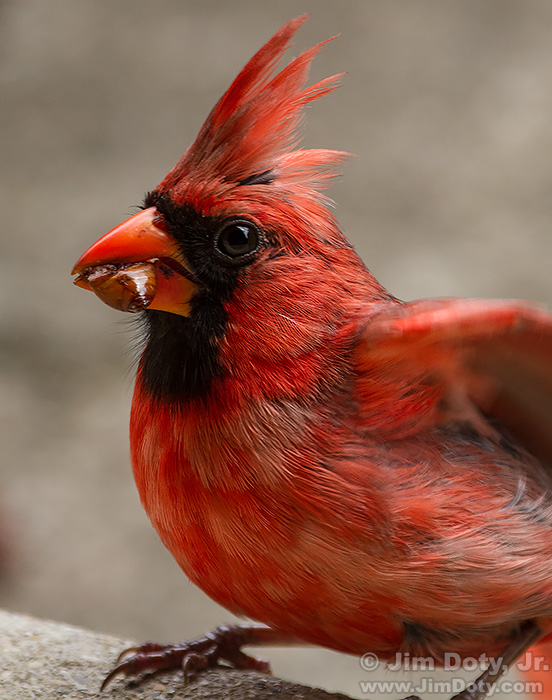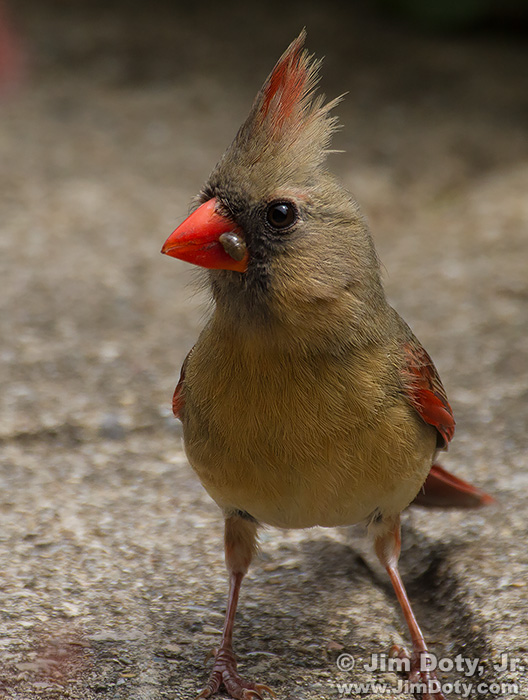It took about 3 1/2 weeks and a lot of patience to get this photo. I was ready from day one but the breeding pair weren’t.
Usually when we get back from two or three walks per day around the neighborhood with our dog, we sit on the front porch, enjoy the view, and I save the walk data on my phone. Sometimes we stay outside and read, drink tall glasses of ice water, or just enjoy the breeze, or chat with neighbors. Our dog sits with us or goes out in the yard to soak up some sunlight.
About 3 1/2 weeks ago we noticed a breeding pair of cardinals hanging around the trees in our front yard with nesting material in their beaks. Sometimes they would fly toward the bushes next to our front porch and then fly away. They were nervous about our presence so we cut our front porch time short and went inside.
Each day as we returned from our walks the cardinals would get a little braver and we would stay on the front porch longer. We kept our dog next to us on the porch. The cardinals would fly into the bushes for a while and then leave. It took a while to figure out which bush had the nest since they spent time in more than one bush, carrying twigs back and forth. We stayed away from the bushes and the cardinals gave me an excuse not to give the bushes a trimming. Little by little they became habituated to our presence. If anyone else came by our house they would leave.
For a while it was just the male and he was bringing food to the nest. Then they both started bringing food to the nest. After three weeks they were both pretty comfortable with us sitting on the porch while they fed the nestlings but they never got really close to us. I kept a camera and long lens nearby, hoping for a great shot. Finally it happened. The male flew up, landed on the porch quite close to me (top photo), watched me for a moment, and then he flew into the bush to feed the nestlings. A little later the female flew up, landed, looked at me (photo below), then headed for the nest.
Focus for both photos was critical. In each case I only used the center focusing point (all the others were off) and focused on the cardinal’s eye. As a general rule you want the eye in focus for almost all wildlife photography. If you have multiple focus points turned on you have no idea which focus point will lock on and whether it will be on the most important part of your subject.
Given the lighting conditions, the tonality of my subjects and the tonality of the background, I set the exposure compensation for both photos to minus 1/3. The lens aperture was set to f/8, one of the sharpest apertures on this lens and most other lenses.
Two days after I took these photos the young cardinals had fledged and left the nest.
Photo Data.
Male Cardinal: Â Canon 7D. Canon EF100-400mm f/4.5-5.6L IS USM lens at 310 mm. 1/250 sec;Â Â f/8;Â Â ISO 400.
Female Cardinal: Â Canon 7D. Canon EF100-400mm f/4.5-5.6L IS USM lens at 400 mm. 1/640 sec;Â Â f/8;Â Â ISO 400.
Links
To learn more about nature photography read Digital Photography Exposure for Dummies. One of the highest rated photography books at Amazon.com, you can order it here through Amazon’s third-party sellers.
Nature Photography Books: The Three Essentials. If you love nature photography, put these books on your “must read†list.
Both of these excellent bird photography books by West and Morris are out of print but you can follow the links below and click on the “Buy at Amazon.com” button to get them from Amazon’s third-party sellers and get Amazon’s guarantee.
How to Photograph Birds by Larry West
The Art of Bird Photography by Arthur Morris
Northern Cardinal information from “All About Birdsâ€, the Cornell Lab of Ornithology.


